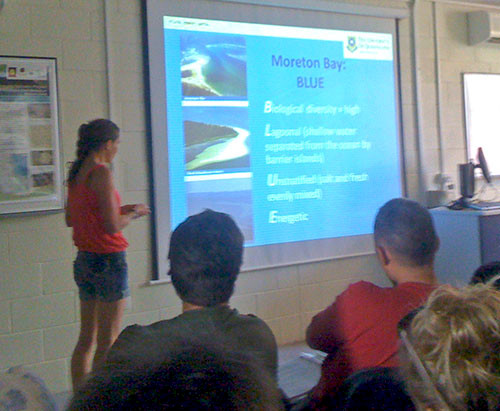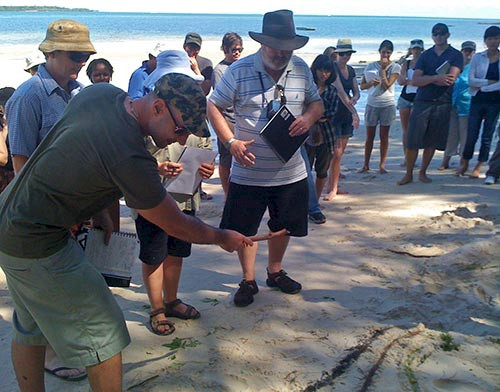International WaterCentre field trip to North Stradbroke Island
Bill Dennison ·The International WaterCentre, formed as a consortium of four Australian universities, offers a Master's degree program in water management. As part of the 18 month (full time) course, a field trip to North Stradbroke Island is included. I attended two of the three days, and led a field trip to the seagrass beds in One Mile Harbor, near the town of Dunwich. The Moreton Bay Research Station in Dunwich was used in the course. The research station was the location of a lot of Marine Botany field work when I was on the faculty of the University of Queensland, and it was nice being back there.
The students were incredibly diverse, from 21 countries, including every continent apart from Antarctica, and ranging in age from 20 to 53 years old. Many students were water management practitioners and brought lots of diverse experiences into the course. I found the student diversity, enthusiasm and creativity refreshing.
The issue of water management on North Stradbroke Island was the central theme, and we were able to listen to a range of speakers and perspectives. The sand mining company perspective was presented by Paul Smith, a former University of Queensland student. He succinctly explained the sand mining processes, distinguishing between silica sand mining versus heavy mineral separation mining, which results in the rare minerals like rutile (converted to titanium), zircon and ilmenite. The water used by the sand mining process is largely recycled back to the island's groundwater. Paul also talked about the rehabilitation process for areas where sand has been mined.
The next speaker, Emma Lewis, from the research station, talked about some of the geomorphological features of Stradbroke Island, and provided an overview of Moreton Bay. She used some slides that I had created early in the Healthy Waterways program development, which I found gratifying. A couple of the slides compared the river estuaries as being BROWN;
Biological diversity = low
Resuspension
Over-loaded
Wastewater
Nutrient-laden
with the Bay as being BLUE;
Biological diversity = high
Lagoonal
Unstratified
Energetic

The next talks were held at Brown Lake, which included lunch and a swim. Leon Leach from the Department of Environment and Resource Management (DERM) talked about groundwater hydrology of the island. Leon explained the indurated, or impermeable layers in the sand that create perched lakes, like Brown Lake, and the importance of groundwater and extraction for drinking water considerations. This was followed by Glenn McGregor, also from DERM, who talked about the ecological manifestations of the hydrology. Glenn did his talk at the edge of Brown Lake with some students actually in the lake. He briefed us on the genetic differentiation between aquatic organisms (fish and invertebrates) on the western versus eastern sides of North Stradbroke Island. Glenn also talked about the relative ages of the various wetlands on the island, with relatively young wetlands like 18 mile swamp and Blue Lake being on the order of 9,000 years old versus some of the older wetlands being up to 40,000 years old. We then went to 18 mile swamp and also walked across the flooded roadway for a visit to Main Beach.
Back at the research station, we had a beautiful slide show by Jan Aldenhoven, from the Stradbroke Island Water Action Group, who was an advocate of the conversion of Stradbroke Island into a national park. It was particularly interesting for the students that she presented such a diametrically opposing view of the island's future from the sand mining perspective.
After having pizza and a few highly appropriate songs by Dr. Peter Oliver, including Dugong Rock (my all time favorite), the students were able to decompress from the day and begin to synthesize the disparate perspectives. The next morning exercise was very interesting. The students were tasked with developing a ten minute briefing on the issues facing North Stradbroke Island, using materials that they could find from the beach. The briefing on the beach was to be for a local mayor and her chief environmental officer. Dr. Peter Oliver and a new IWC staffer, Dr. Dana Kelly, posed as the Mayor and her environmental officer, respectively, to provide a deadly accurate example of the sort of comments and questions that would come from local elected officials and their staff. Students were divided into small groups, and they employed various creative methods of communicating the issues. Many groups constructed sand island models, often with cross sections illustrating ground water levels, and various symbolic icons to represent community values, economic issues and indigenous values. They communicated the issues of water management, sand mining and opposing values using the models, and in one case, staged a hilarious skit featuring a sand miner, an indigenous Australian and the Queensland Premier.

The final activity was a field trip out to the sand flats in front of Moreton Bay Research Station. We stopped and discussed mangroves next to a Gray Mangrove (Avicennia marina), observed depressions in the sand created by feeding rays, and watched tiny blue soldier crabs scurrying about. We then went to the edge of the channel to see several species of seagrass (Syringodium isotefolium, Cymodocea serrulata, Zostera capricorni). We also saw Caulerpa taxifolia, the species of green macro algae that has been introduced to the Mediterranean Sea, with deleterious ecological consequences. Then we made our way to the edge of the Rainbow Channel to observe an area of recent heavy grazing by dugong. We saw the seagrasses Halophila ovalis and Halodule uninervis, two species that dugong cultivate through repeated grazing. We also saw various other macroalgal species, a string ray, holothurians (sea cucumbers) and sponges before the incoming tide chased us into shore.
The weekend field trip provided an opportunity for the students and instructors to get to know one another, and for the students to work in teams on complex issues and begin to both synthesize and communicate those issues. Perfect weather, great facilities at Moreton Bay Research Station, and a thought-provoking agenda made for a stimulating and enjoyable experience.
About the author
Bill Dennison

Dr. Bill Dennison is a Professor of Marine Science and Vice President for Science Application at the University of Maryland Center for Environmental Science.

